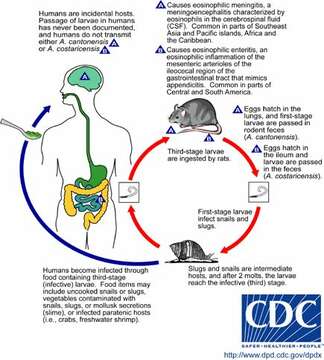Life cycle of Angiostrongylus cantonensis and A. costaricensis

Description:
Life cycle of Angiostrongylus cantonensis and A. costaricensis
Adult Rat Lungworms (Angiostrongylus cantonensis) (A) are parasitic nematodes (roundworms) that live in the pulmonary arteries of rats. The females lay eggs that hatch, yielding first-stage larvae, in the terminal branches of the pulmonary arteries. The first-stage larvae migrate to the pharynx, are swallowed, and pass in the feces. They penetrate, or are ingested by, an intermediate host (snail or slug). After two molts, third-stage larvae are produced, which are infective to mammalian hosts. When the mollusk is ingested by the definitive host, the third-stage larvae migrate to the brain where they develop into young adults. The young adults return to the venous system and then to the pulmonary arteries, where they become sexually mature. A variety of animals can act as paratenic (transport) hosts: after ingesting the infected snails, they carry the third-stage larvae, which can resume their development when the paratenic host is ingested by a definitive host. Humans can acquire the infection by eating raw or undercooked snails or slugs infected with the parasite; they may also acquire the infection by eating raw produce that contains a small snail or slug, or part of one. There is some question whether or not larvae can exit the infected mollusks in slime (which might be infective to humans if ingested, for example, on produce). The disease can also be acquired by ingestion of contaminated or infected paratenic animals (crabs, freshwater shrimps). In humans, juvenile worms migrate to the brain, or rarely to the lungs, where they ultimately die. The life cycle of Angiostrongylus (Parastrongylus) costaricensis (B) is similar, except that the adult worms reside in the arterioles of the ileocecal area of the definitive host. In humans, A. costaricensis often reach sexual maturity and release eggs into the intestinal tissues. The eggs and larvae degenerate, causing intense local inflammatory reactions, and do not appear to be shed in the stool.
From Centers for Disease Control Parasites and Health website.
Included On The Following Pages:
This image is not featured in any collections.
Source Information
- license
- cc-by-nc
- copyright
- Centers for Disease Control/Division of Parasitic Diseases and Malaria
- publisher
- Shapiro, Leo
- photographer
- Centers for Disease Control/Division of Parasitic Diseases and Malaria
- provider
- EOL Rapid Response Team
- original
- original media file
- visit source
- partner site
- EOL staff
- ID


